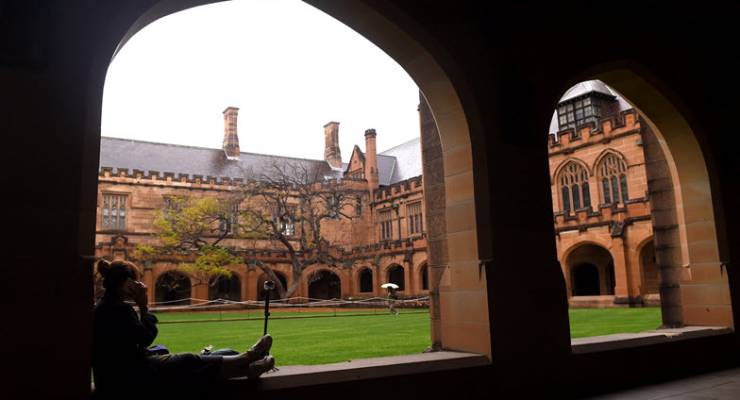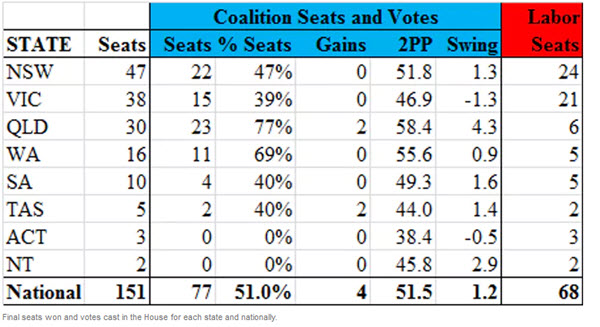
At the May 18 election, the size of the lower house was expanded from 150 to 151 seats. The Coalition parties won 77 seats (up one since the 2016 election), Labor 68 (down one) and the crossbench six (up one). The Coalition government holds a three-seat majority.
Owing to redistributions and the loss of Wentworth to independent Kerryn Phelps at an October 2018 byelection, the Coalition notionally had 73 seats before the election, a one-seat advantage over Labor. Using this measure, the Coalition gained a net four seats in the election.
The Coalition gained the Queensland seats of Herbert and Longman, the Tasmanian seats of Braddon and Bass, and the New South Wales seat of Lindsay. Labor’s only offsetting gain was the NSW seat of Gilmore. Corangamite and Dunkley are not counted as Labor gains as they were redistributed into notional Labor seats.
Four of the six pre-election crossbenchers easily held their seats — Adam Bandt (Melbourne), Andrew Wilkie (Clark), Rebekha Sharkie (Mayo) and Bob Katter (Kennedy). The Liberals narrowly regained Wentworth from Phelps, but independent Zali Steggall thrashed Tony Abbott 57%-43% in Warringah. In Indi, independent Helen Haines succeeded retiring independent Cathy McGowan, defeating the Liberals by 51.4%-48.6%.
The Coalition easily defeated independent challengers in Cowper and Farrer.
While Bandt was re-elected, the Greens went backwards in their other inner-Melbourne target seats of Wills and Cooper. Only in Kooyong did the Greens manage to beat Labor into second.
The final primary votes were 41.4% Coalition (down 0.6%), 33.3% Labor (down 1.4%), 10.4% Greens (up 0.2%), 3.4% United Australia Party (UAP) and 3.1% One Nation (up 1.8%).
The final two-party vote was 51.5% for the Coalition to 48.5% for Labor, a 1.2% swing in the Coalition’s favour from the 2016 election. It is the first pro-government swing since the 2004 election.
It was expected the Coalition would do better once the 15 “non-classic” seats were included; these are seats where the final two candidates were not Coalition and Labor. However, 11 of these seats swung to Labor, including a 9.0% swing in Warringah and a 7.9% swing in Wentworth. Eight non-classics were inner-city electorates that tended to swing to Labor.
The table below shows the number of seats in each state and territory, the Coalition’s number of seats, the Coalition’s percentage of seats, the gains for the Coalition compared to the redistribution, the Coalition’s two-party vote, the swing to the Coalition in two-party terms, and the number of Labor seats.

Four of the six states recorded swings to the Coalition in the range from 0.9% to 1.6%. Victoria was the only state that swung to Labor, by 1.3%. Queensland had a 4.3% swing to the Coalition, far larger than any other state. Labor did well to win a majority of NSW seats despite losing the two-party vote convincingly.
Official turnout in the election was 91.9%, up 0.9% from 2016. Analyst Ben Raue says 96.8% of eligible voters were enrolled, the highest ever. That means effective turnout was 89.0% of the population, up 2.6%.
Education divide explains Coalition’s win
Not only did Steggall thump Abbott in Warringah, the electorate’s 9.0% swing to Labor on a two-party basis was the largest swing to Labor in the country. Abbott’s two-party vote percentage of 52.1% was by far the lowest for a conservative candidate against Labor since Warringah’s creation in 1922; the next lowest was 59.5% in 2007.
While Abbott did badly, other divisive Coalition MPs performed well. Barnaby Joyce won 54.8% of the primary vote in New England and gained a 1.2% two-party swing against Labor. Peter Dutton had a 3.0% two-party swing to him in Dickson, and George Christensen had a massive 11.2% two-party swing to him in Dawson, the second-largest for the Coalition nationally.
According to the 2016 census, 42% of those aged 16 and over in Warringah had at least a bachelor’s degree, compared with 22% in Australia overall. Just 13.5% had at least a bachelor’s degree in New England, 19% in Dickson and 12% in Dawson.
In Victoria, which swung to Labor, 24.3% of the population had at least a bachelor’s degree in 2016, the highest of any state in the nation.
The Grattan Institute has charted swings to Labor and the Coalition, taking into account wealth and tertiary education. Only polling booths in the top-income quintile swung to Labor; the other four income quintiles swung to the Coalition.
Areas with low levels of tertiary education swung strongly to the Coalition in NSW and Queensland, but less so in Victoria. There were solid swings to Labor in areas with high levels of tertiary education.
Some of the swings are explained by contrary swings in 2016, when the Coalition under Malcolm Turnbull performed relatively worse in lower-educated areas and better in higher-educated areas. However, Queensland’s 58.4% two-party vote for the Coalition was 1.4% better than at the 2013 election, even though the national result is 2.0% worse. The large swings to the Coalition in regional Queensland are probably partly due to the Adani coal mine issue.
Morrison’s appeal to lower-educated voters
Since becoming prime minister, Scott Morrison’s Newspoll ratings have been roughly neutral, with about as many people saying they are satisfied with him as those dissatisfied. After Morrison became leader, I suggested on my personal website that the Coalition would struggle with educated voters, and this occurred in the election. However, Morrison’s appeal to those with a lower level of education more than compensated …
Read the rest of this piece over at The Conversation








As per HG Wells “Civilization is in a race between education and catastrophe.” Looks like catastrophe is now well ahead, but I pray there will be a miracle that proves me wrong.
A win (from appealing to egocentric gut-feelings) over erudition – come here future.
Ahh- the bliss of the ignorant and uneducated, don’t have to worry about inner city elite problems such as climate change, mental health problems, woman and gay issues etc etc. Just keep driving the twin cab ute and lets go and shoot a few Roo’s!
Conclusion: The inner city luvvies, many in cushy unsackable Government jobs can afford to worry about climate change, diversity and sundry other indulgences; while those who do most of the world’s work worry about how to pay for all this BS.
Election Result: Workers 1, Luvvies 0.
I wish people would stop using a university degree as a proxy for being “educated”.
We’re telling people that being a tradie is an OK career path, but it looks like you’ll be tagged as “uneducated” for the rest of your life.
With so many bullshit university degrees nowadays, it’s a stretch to infer anyone who went to university as being educated.
Disclaimer: I have degrees in Maths and Statistics (but so what).
I understand that however; what’s your propensity to rally behind the misogynistic, racially vilifying and commies coming over the hill type rhetoric we get from the likes of Christensen, Dutton, Palmer and Hanson? Yep, zero, with a p<0.01 .
So I’m guessing raising levels of education won’t be a long term priority of the Coalition if it is a factor that keeps them in government.